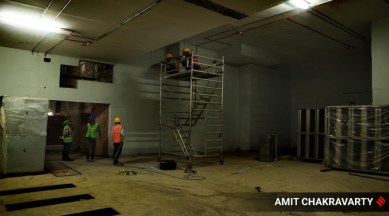Stay updated with the latest - Click here to follow us on Instagram
Bandra Kurla Complex longest station of Mumbai’s underground Metro line 3
In the BKC station area, Line-3 has the Back-up Control Centre (BCC), which will control all activities of Phase-1 (BKC-SEEPZ) operations till the Operation Control Centre (OCC) at Aarey depot gets fully functional, the MMRC said.

The first underground Mumbai Metro Line-3, passing through Colaba-Bandra-SEEPZ, has the longest station at Bandra Kurla Complex (BKC), which is almost half a kilometre long (474 m) and 32.5-m wide. It is bigger than any other station on Line-3 — a standard station on the line is 250-m long and 25-m wide.
“Over 600 labourers, both skilled and unskilled, are working round the clock to finish work to ensure timely commissioning of Phase-1 (BKC-SEEPZ) of Line-3 by December 2023,” said an official of the Mumbai Metro Rail Corporation (MMRC), which is implementing the project.
monthly limit of free stories.
with an Express account.
In the BKC station area, Line-3 has the Back-up Control Centre (BCC), which will control all activities of Phase-1 (BKC-SEEPZ) operations till the Operation Control Centre (OCC) at Aarey depot gets fully functional, the MMRC said.
The reason behind having the longest Metro station at BKC is that it comprises ‘scissor crossover’ from both sides — permitting travel in either direction between parallel tracks — at the end of the platforms, facilitating stabling and turnback of trains towards Cuffe Parade to meet higher traffic demand between BKC and Cuffe Parade.
“This station will be a mid-terminal of underground Metro Line-3, allowing services from Colaba to terminate at BKC and vice-versa. Additional platform will facilitate that, as unlike other Metro-3 stations, BKC has three tracks,” the official said.
The station has nearly 15,000 sq ft of usable area, of which 2,000 sq ft is dedicated for commercial space. The Indian Express visited the station construction site and found that elevators, escalators, tiling work on floors and walls and laying of track was ongoing.
Interestingly, at BKC Metro Line-3, provision has been made to connect with the upcoming Mumbai-Ahmedabad Bullet train in future. An MMRC official said, “A false wall has been built, so whenever the high-speed bullet train connectivity comes, it can be merged easily.”
Workers have been deployed in three different shifts. The MMRC official said that since the tunnelling work of the BKC project is ready, the workers are engaged in other activities.
As per the MMRC, the stabling line tunnels — where empty trains are stabled — on both sides of BKC station have been constructed by New Austrian Tunnelling Method (NATM) while the main line tunnels have been constructed by Tunnel Boring Machine.
The MMRC further stated that a part of the tunnel from BKC towards Dharavi passes below Mithi river. There is a 9.57-m gap from the riverbed of Mithi to the crown of the tunnel. “Tunneling below Mithi river was one of the major challenges of Metro Line-3. The MMRC team with its engineering acumen and help of technology surmounted this challenge successfully,” the official said.
The BKC station, being the longest station of Line 3, has a total six public entries and exits excluding the emergency points. Furthermore, the station is equipped with 30 escalators and 12 lifts. Since Mumbai is a flood-prone area being a coastal city and the upcoming BKC station being very near to Mithi river, the entry-exits have been built at a height after analysing the flood level height of past 100 years and of future estimation of next 100 years. This is to ensure that the water does not enter the station during heavy downpour.
The official informed that except entry and exits, there is no other way through which water can enter the station so there is no risk of waterlogging.
Moreover, since the Metro Line-3 is passing underground, each station will have an air handling unit.
According to the MMRC the air handling unit, commonly called an AHU, is a unit used for appropriate ventilation, purification, air-conditioning or renewing the indoor air in a building or premises. It collects outside air and room air, removes dust and other particles from the collected air, adjusts the temperature and humidity and then supplies comfortable and refreshing air-conditioned air into the rooms through ducts.